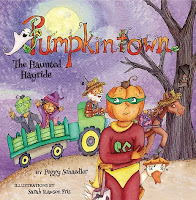It is still
ADHD Awareness Month, but instead of reading widely on the subject, I am still focused on J. Russell Ramsay's article
Why the ADHD Brain Prioritizes the Less Important Task--And How CBT Improves Prioritization Skills in
ADDitude. (Maybe I'm a little hyperfocused?) Today I'm interested in the second part of the article, about improving prioritization skills.
First off, CBT is cognitive behavioral training, which Ramsay simply describes as a type of brain training. So, we've got that out of the way.
The first suggestion Ramsay makes was the one that I found particularly meaningful. He called it "Attach manual, step-by-step descriptions to must-do tasks." I think this just means specifically break down tasks.
This concept jumped out at me, because just a few days before I read this article, I happened to have a week when I only had an hour here or there to write. One evening I decided I wouldn't just write the next day, I would work on Dinner at Shirley Farr's House. And I wouldn't just work on Shirley Farr, I would begin by moving a section of the piece about my family to the beginning of the essay, instead of beginning with Shirley Farr. I wanted this memoir to be related to my writing about eating. Plus, it was a memoir. It should be about a personal experience involving Shirley Farr, not about Shirley Farr. I suspect someone could write a book about her, but it won't be me.
Knowing what I was specifically going to do before I sat down to work was hugely helpful. It was as if I didn't have to start the job, it was already started. What's more, being able to get that kind of start made it easier to continue.
Maybe We Could Think in Terms of Goals and Objectives
Okay, that one example of how I had broken down a writing task should not convince anyone that attaching a step-by-step description to writing is a best practice for that job. Because one is not a statistically significant number. But think of a "must-do task" as a
goal and the "step-by-step descriptions" as
objectives. Now we're talking about
something we have experience with.
"Writing tomorrow" is big and overwhelming. Also, morning is a lot of time. Surely, I can use some of that to see what's trending on X and go to Facebook, not just to look at my wall but to check a bunch of my groups to see if something has happened that I've missed. (I belong to many, many Facebook groups.)
But those of us who are accustomed to working with goals and objectives can see that "writing tomorrow" is the must-do goal we need to do. Of course, we need to assign step-by-step objectives to that goal.
What am I going to write tomorrow?
- I'm going to work on Project C
- I'm going to start with looking at yesterday's work
- I'm going to work on the section related to _________
- I'm going to create a voice
- I'm going to maintain the voice
- I'm going to shorten the part about__________
The point being that if we apply objectives or step-by-step descriptions to "going to write tomorrow," when we sit down to work, we know exactly what we have to, and are going to, do. Yes, that makes work easier. You know what else it does? It gets rid of the anxiety about what we're going to do. What a relief.
A Good Time to Mention Bullet Journals?
I get a lot done with a bullet journal. Though, of course, never as much as I want to. Also, sometimes in order to get a long-standing task done, I have to put it in my bullet journal. But that's okay!
An example of how my simplistic bullet journal works.
Week of Oct. 27th Work Section (I may add more during the week):
- Submit scifi story
- Submit reprint story
- Plan next writing projects (I could have got more detailed with this, as in "check started work on laptop" and "check journal.") /
Humor/Raw Dog postTMT post (that's this one) - Register for workshop
- Update website.
Week of Oct. 27th Food Section (I will probably add more during the week. Also, this is usually cooking related.):
gf cider doughnutsgf cider biscuits
Each week has additional sections for other aspects of my life. Strike throughs mean a task is done. A slash means I've started it.
My point here is that I think that if you work with some kind of bullet journal system, it seems as if what you're doing is, indeed, attaching "manual, step-by-step descriptions to must-do tasks," as Ramsay describes in his
ADDitude article. So you may not be surprised to hear that a few years ago, while doing some reading about bullet journals, I learned that
Ryder Carroll, who created the bullet journal system, has ADHD.
ADDITION: I mentioned a few weeks ago that we have a family member who has recently been diagnosed with ADHD. This is a child I'm talking about. So today I thought I'd take a look see if there's anything about bullet journals/journaling for kids. I'm having a hard time finding something that isn't focused on the idea of "journals" and not "productivity," let alone "mindfulness designed as a productivity system." My gut feeling is these kids don't need to keep records of what they have done or their creativity and personalities. They need help focusing on what they need to do and getting things done. Which is what the original bullet journal is about.
I will keep looking!












.jpg)















